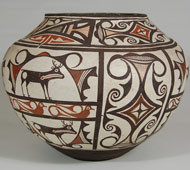Adobe Gallery Blog
Subject: Zuni Pueblo Polychrome Jar by Tsayutitsa, c.1935
Tsayutitsa, also known as Mrs. Milam's mother, was certainly one of the finest potters of the first half of the 20th century from Zuni Pueblo. She is known for her superbly formed jars and meticulous painting of designs. Her pottery was not signed but it is unmistakably identified by the superb craftsmanship. This jar is without a doubt the work of Tsayutitsa.
Dr. Edwin Wade has examined this jar and prepared a document of description and authentication, which we reprint below:
A ZUNI POLYCHROME JAR BY TSAYUTITSA C. 1935
 "Zuni stylistic conventions may appear broadly consistent over time. However, prior to the mid-19th century, the potters of the Kiapkwa and earlier Ashiwi traditions (forerunners of modern Zuni) were notably experimental. These earlier times witnessed increased pan-Puebloan communication and travel and through this widened contact new ideas flowed.
"Zuni stylistic conventions may appear broadly consistent over time. However, prior to the mid-19th century, the potters of the Kiapkwa and earlier Ashiwi traditions (forerunners of modern Zuni) were notably experimental. These earlier times witnessed increased pan-Puebloan communication and travel and through this widened contact new ideas flowed.
"The second half of the 19th century, with the coming of Anglo settlers and a host of new diseases, was difficult for all the Pueblos, but particularly for the remote communities of Hopi and Zuni. The harshness of these times likely contributed to an aesthetic and compositional entrenchment of Zuni. Yet, as attested to by early anthropologists, conservatism may also spring from a group psyche in which difference and the unusual are approached with distrust and aversion. The more that Zuni became 'stay at home' the greater their preference for a limited number of design compositions and layouts such as 'deer jars' and hachured 'rain birds' and rectangular geometrics.
"There was assuredly a positive side to this conservatism, as evidenced in this beautifully shaped and painted jar. The flashiness of innovation can obscure degrees of artistic perfectionism and technical excellence. Within Zuni ceramics, it's impossible to hide lack of artistic skill behind the glamour of the new and unusual.
"The deer pot pictured above is composed of four vertical under- to upper-body design fields, two of which have three horizontally stacked panels containing housed black deer separated by a band of serially repeated red birds, offset by two elongated rectangular panels which each contain one arabesque Spanish-derived motif. This particular composition first arose in the late 1860s to early 1870s and has been a hallmark of Zuni art ever since.
"Comparing such vessels from their inception to the present day easily separates the vast majority of rank and file competent talent from that of the very few geniuses. This jar, made in 1935 by the master Zuni potter Tsayutitsa (1870s - 1959), is one of those few masterpieces.
"By the turn of the 20th century, Zuni pottery was in decline. Certain scholars maintain that only three or so potters of that time were capable of matching the greatness of their 19th century counterparts. And of those few, Tsayutitsa was unquestionably the best. She specialized in oversized storage jars, which likely was a result of her working for the Indian trader C. G. Wallace. Wallace was widely known for supplying museums and advanced collectors with the finest of ancient and modern Zuni art.
"Her vessels are characterized by bulbous, bubble-like bodies with a sharp upperbody (sic) flexure from which a short conical neck arises. A heavy white kaolin slip was applied to the clay body and meticulously stone polished. The result is a creamy, lustrous finish that is finely crazed. The vessels are thin-walled and the painting is richly-colored, extremely precise, and refined.
"Notably, in addition to all these traits, this jar displays one of the earliest known evidences of an artist's 'signature' on Pueblo pottery at a time well before this became common practice. This jar is inscribed on the interior of the upper shoulder as follows: 'ZUNI 1935 N. M.' These words, almost certainly written by the potter, are executed in child-like, large block capital letters and are rendered in the exact same red paint used by the artist in painting the exterior design of the jar. UV light examination reveals that the inscription was applied after the vessel was fired. It is possible that this 'signature' could have been added at the behest of Tsayutitsa's longtime patron, trader C. G. Wallace, to mark the jar for participation in or a competition judging at an event such as the nearby Gallup Ceremonial. In any event, this marvelous inscription is unique in my experience and is another testament to the special and compelling nature of this vessel.
"In my estimate, Tsayutitsa is one of the master Pueblo potters along with Nampeyo of Hopi and Maria Martinez of San Ildefonso. I am not alone in this assessment as reflected in the comments of Robert Gallegos in describing a Tsayutitsa jar for sale at Skinner's auction (Sale 2376 - lot 340) 'Tsayutitsa was a great potter and a great painter, making her in my opinion, one of the best, if not the best potter of all time.'
"Museums throughout the United States are now combing their collections with new expertise in the hope of finding a Tsayutitsa within their holdings. When one is found it is rushed to the exhibition gallery. To personally own one of her vessels is a rare privilege as she is deserving of a hallowed place within any collection."
/// Signature ///
Edwin L. Wade, Ph.D.
Condition: excellent condition
Provenance: from a gentleman in Santa Fe
Recommended Reading: The Pottery of Zuni Pueblo by Harlow and Lanmon
Subject: Zuni Pueblo Polychrome Jar by Tsayutitsa, c.1935
Artist / Potter: Tsayutitsa (1870s - 1959)
Category: Historic
Origin: Zuni Pueblo
Medium: clay, pigment
Size: 8-7/8" tall x 11-3/8" diameter
Item # 25612

